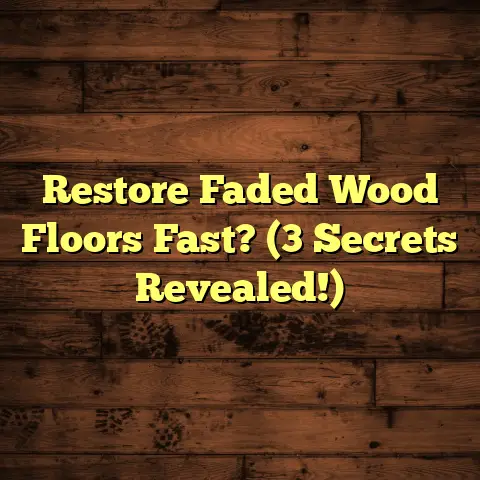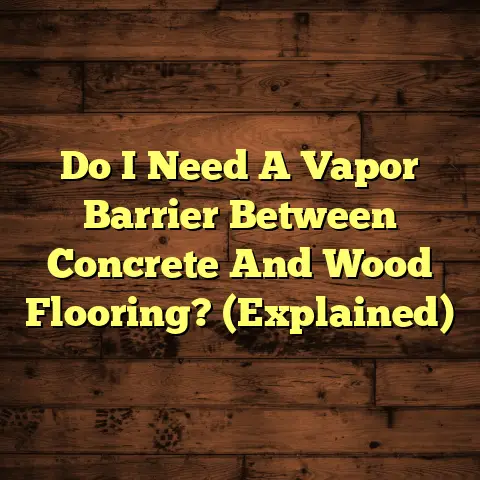Laminate or Vinyl? Know NOW! (5 Second Test)
Are you tired of wasting time and money on flooring that doesn’t meet your needs?
I get it. Choosing the right flooring can feel like navigating a minefield.
You want quality, durability, and style, but without breaking the bank or spending weeks on installation. That’s where laminate and vinyl come in.
Both are popular choices, but they have unique benefits and drawbacks. Making the right call is critical.
Let’s cut through the confusion and get you the perfect floor, fast!
Section 1: Understanding the Basics of
Laminate and Vinyl Flooring
Okay, let’s break down what we’re dealing with. Forget the fancy marketing jargon; I’m going to give you the straight goods.
What is Laminate Flooring?
Think of laminate as a multi-layered sandwich. It’s got a high-density fiberboard (HDF) core, topped with a decorative layer that looks like wood, stone, or tile.
That decorative layer is actually a printed image, protected by a clear, durable wear layer. Here’s the breakdown:
-
Wear Layer: The top, clear coat that protects against scratches, stains, and fading.
-
Decorative Layer: The printed image that gives the floor its look.
-
Core Layer: The HDF core, providing stability and impact resistance.
-
Backing Layer: A bottom layer for balance and moisture resistance.
What is Vinyl Flooring?
Vinyl flooring is a whole different beast. Instead of layers glued together, it’s primarily made of polyvinyl chloride (PVC).
You’ll find it in a few forms:
-
Sheet Vinyl: Big rolls, usually installed in single pieces. Great for bathrooms because it minimizes seams.
-
Vinyl Tile: Individual tiles, often square, that can be arranged in patterns.
-
Vinyl Plank: Long, narrow pieces that mimic hardwood planks. My personal favorite!
Each type has its own construction, but generally, you’ll find these layers:
-
Wear Layer: Similar to laminate, protects against wear and tear.
-
Print Layer: The decorative image.
-
Core Layer: Solid vinyl or a composite material for stability.
-
Backing Layer: Provides cushioning and helps with installation.
Key Differences: Installation,
Maintenance, and Durability
Here’s a quick table to highlight the major differences:
| Feature | Laminate | Vinyl |
|---|---|---|
| Installation | Often click-lock, DIY-friendly | Can be glue-down, click-lock, or loose-lay |
| Maintenance | Dry mopping, avoid excessive water | Damp mopping, very water-resistant |
| Durability | Good for general use, less water-resistant | Excellent water resistance, good for high-traffic |
| Water Resistance | Moderate | High |
| Cost | $1-$5 per square foot | $2-$6 per square foot |
| Lifespan | 10-20 years | 10-25 years |
Section 2: The 5 Second Test Explained
Alright, let’s get to the good stuff!
I’ve developed a “5 Second Test” to help you quickly assess whether laminate or vinyl is the right choice for you.
It’s not a scientific guarantee, but it’s a great starting point.
The goal is to rapidly consider the most important factors for your specific situation. We’re talking gut reaction here.
The Steps:
-
Visualize the Space: Close your eyes and picture the room where the flooring will be installed.
-
Foot Traffic: Imagine how much foot traffic that area gets. Is it a busy hallway or a quiet bedroom?
-
Moisture Exposure: Think about the potential for spills, humidity, or direct water contact.
-
Aesthetic Preferences: What look are you going for? Modern, rustic, classic?
-
Quick Decision: Based on those factors, which flooring intuitively feels like a better fit?
Factors to Consider:
-
High Foot Traffic: If you’re dealing with kids, pets, or a heavily used entryway, durability is key. Vinyl often wins here.
-
Moisture-Prone Areas: Bathrooms, kitchens, and basements need water resistance. Vinyl is the clear winner.
-
Aesthetic Goals: Laminate offers a wider range of realistic wood and stone looks. If appearance is paramount, laminate might be your choice.
-
Budget: Laminate is often more budget-friendly upfront.
-
DIY Skills: Laminate is generally easier to install yourself.
Example Scenarios:
-
Bathroom: 5 Second Test says: WATER! Vinyl is the obvious choice.
-
Living Room: 5 Second Test says: STYLE! Consider laminate for its realistic wood look, but factor in foot traffic.
-
Basement: 5 Second Test says: MOISTURE! Vinyl is the safer bet.
Section 3: Pros and Cons of Laminate Flooring
Let’s dive deeper into laminate and see where it shines and where it falls short.
Advantages of Laminate:
-
Affordability: Laminate is generally cheaper than hardwood or tile. This makes it a great option if you’re on a budget.
-
Ease of Installation: Most laminate floors use a click-lock system, making them relatively easy to install yourself. I’ve seen homeowners with zero experience tackle laminate projects successfully.
-
Variety of Styles: Laminate comes in a huge range of styles, mimicking everything from oak and maple to slate and travertine.
-
Durability: Laminate is scratch-resistant and can withstand everyday wear and tear.
Disadvantages of Laminate:
-
Susceptibility to Moisture Damage: This is laminate’s biggest weakness. If water seeps into the seams, the core can swell and warp. I’ve seen entire floors ruined by a single leaky dishwasher!
-
Limited Refinishing Options: Unlike hardwood, you can’t sand down and refinish laminate. Once the wear layer is damaged, you’ll need to replace the planks.
-
Can Feel Hard Underfoot: Laminate doesn’t have the same cushioning as vinyl or carpet. It can feel a bit hard and cold, especially in the winter.
Real-Life Scenarios:
-
The Good: I installed laminate flooring in a client’s dining room. They loved the look of hardwood but didn’t want the expense. The laminate held up beautifully to dinner parties and everyday use.
-
The Bad: Another client installed laminate in their laundry room. A washing machine hose burst, and the floor was destroyed. They learned a hard lesson about moisture and laminate.
Section 4: Pros and Cons of Vinyl Flooring
Now, let’s turn our attention to vinyl. It’s a versatile and increasingly popular flooring option, but it’s not perfect.
Benefits of Vinyl:
-
Water Resistance: This is vinyl’s superpower. It’s virtually waterproof, making it ideal for bathrooms, kitchens, and basements.
-
Comfort Underfoot: Vinyl has more give than laminate or tile. It’s softer and warmer, making it more comfortable to walk on.
-
Durability Against Scratches and Dents: Vinyl is tough stuff. It can withstand heavy foot traffic, pet claws, and dropped objects.
-
Easy to Clean: Vinyl is a breeze to clean. Just sweep, vacuum, or damp mop.
Potential Downsides:
-
Potential Fading in Direct Sunlight: Some vinyl floors can fade over time if exposed to direct sunlight.
-
Complexity of Installation (Certain Types): Sheet vinyl can be tricky to install properly. It requires careful cutting and seaming. Vinyl tile and plank are generally easier to DIY.
-
Can Show Indentations: Heavy furniture can leave indentations in softer vinyl floors.
Case Studies:
-
The Success Story: I installed luxury vinyl plank (LVP) in a client’s basement. They had previously dealt with flooding, so water resistance was a must. The LVP looked great and held up perfectly, even after a minor water leak.
-
The Learning Experience: Another client chose a cheaper vinyl sheet for their kitchen. It looked good initially, but it quickly showed wear and tear. They regretted not spending a bit more on a higher-quality product.
Section 5: Comparing Aesthetics and Design Options
Okay, let’s talk looks! After all, your floor is a major design element in your home.
Laminate’s Visual Appeal:
Laminate excels at mimicking the look of real hardwood. You can find laminate floors that look almost indistinguishable from oak, maple, hickory, and even exotic woods.
The textured surfaces and realistic grain patterns add to the illusion. Laminate also comes in stone and tile looks.
Vinyl’s Design Versatility:
Vinyl has come a long way in recent years. High-end vinyl plank can also convincingly replicate the look of wood, and it often has the added benefit of being textured.
Vinyl tile offers a wider range of patterns and colors, from classic checkerboard to modern geometric designs. Sheet vinyl allows for seamless designs and intricate patterns.
Flooring Design Trends:
-
Wide Plank: Wide planks are popular in both laminate and vinyl, creating a more spacious and modern look.
-
Gray Tones: Gray flooring is trending in both wood and stone looks.
-
Waterproof: Waterproof flooring is becoming increasingly popular, especially in kitchens and bathrooms.
-
Textured Surfaces: Textured surfaces add realism and depth to both laminate and vinyl floors.
Popular Styles:
-
Laminate: Oak, hickory, maple, slate, travertine.
-
Vinyl: Wood-look plank, stone-look tile, geometric patterns, solid colors.
Section 6: Cost Analysis and Long-term Value
Let’s talk money! Understanding the costs involved is crucial for making an informed decision.
Initial Costs:
-
Laminate: $1-$5 per square foot (materials only). Installation can add another $1-$3 per square foot.
-
Vinyl: $2-$6 per square foot (materials only). Installation costs vary depending on the type of vinyl.
Long-Term Value:
-
Lifespan: Laminate typically lasts 10-20 years, while vinyl can last 10-25 years.
-
Maintenance Costs: Both laminate and vinyl are relatively low-maintenance. You’ll need to factor in the cost of cleaning supplies and occasional repairs.
-
Resale Value: Flooring can impact your home’s resale value. While neither laminate nor vinyl adds as much value as hardwood, they can still be a selling point if they’re well-maintained and stylish.
Cost Comparison Over Time:
Here’s a simplified example:
| Flooring | Initial Cost (1000 sq ft) | Lifespan | Replacement Cost | Total Cost |
|---|---|---|---|---|
| Laminate | $3,000 | 15 years | $3,000 | $6,000 |
| Vinyl | $4,000 | 20 years | $0 | $4,000 |
This table shows that even though vinyl has a higher initial cost, its longer lifespan can make it a better value in the long run.
Section 7: Environmental Considerations
Let’s not forget about our planet! Choosing eco-friendly flooring is becoming increasingly important.
Laminate’s Eco-Friendliness:
Laminate is often made from recycled wood fibers. Look for laminate floors that are certified by the Forest Stewardship Council (FSC).
Vinyl’s Environmental Impact:
Traditional vinyl is made from PVC, which is a petroleum-based product. However, there are now more eco-friendly vinyl options available, such as recycled vinyl and bio-based vinyl.
Certifications and Standards:
-
FSC: Forest Stewardship Council (for laminate).
-
FloorScore: Ensures low VOC emissions (for both laminate and vinyl).
-
GreenGuard: Another certification for low VOC emissions.
Section 8: Final Decision-Making Factors
Okay, let’s bring it all together!
Remember the “5 Second Test”? It’s time to revisit it. Think about your personal needs, lifestyle, and home environment.
-
Moisture: If moisture is a concern, vinyl is the clear winner.
-
Budget: Laminate is often more affordable.
-
Aesthetics: Both laminate and vinyl offer a wide range of styles.
-
Durability: Vinyl is generally more durable, especially in high-traffic areas.
-
Installation: Laminate is often easier to install yourself.
Conclusion:
Choosing the right flooring is a big decision. But by understanding the differences between laminate and vinyl, you can make the right choice for your needs.
Don’t delay! Take action based on your newfound knowledge and get the perfect floor for your home today!





